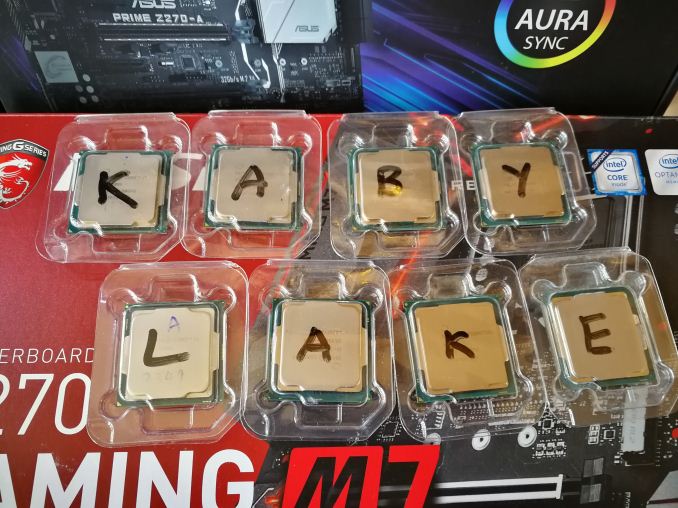The Intel Core i7-7700K (91W) Review: The New Out-of-the-box Performance Champion
by Ian Cutress on January 3, 2017 12:02 PM ESTThe New Champion
Given that Intel has no competition, it is perhaps easy to roll out a new mainstream performance champion – all they have to do is have more stringent binning techniques (like perhaps AMD with the FX-9000 series) and a few processors with a higher frequency could pop-out. The danger here is that Intel always sells a lot of its top performer – millions. If you have to dump 100 processors to find one that fits the mold of the top SKU, you either have to charge lots for it or reduce the rules. The only way to get that mix of yield and viability is by improving how the CPU is made. This is what the ‘optimization’ in Kaby Lake is for.
The Core i7-7700K sits at the top of the stack, and performs like it. A number of enthusiasts complained when they launched the Skylake Core i7-6700K with a 4.0/4.2 GHz rating, as this was below the 4.0/4.4 GHz rating of the older Core i7-4790K. At this level, 200-400 MHz has been roughly the difference of a generational IPC upgrade, so users ended up with similar performing chips and the difference was more in the overclocking. However, given the Core i7-7700K comes out of the box with a 4.2/4.5 GHz arrangement, and support for Speed Shift v2, it handily mops the floor with the Devil’s Canyon part, resigning it to history.
In most of our benchmarks, the results are clear: a stock Core i7-7700K beat our overclocked Core i7-4790K in practically every CPU-based test (Our GPU tests showed little change). When overclocked, the i7-7700K just pushed out a bigger lead for only a few more watts. Technically one could argue that because this part and the i7-6700K are equal in IPC, a similar overclock with the i7-6700K achieves the same performance. But the crucial matter here is how lucky a user is with the silicon lottery – based on our testing, the Core i7-7700K CPUs tend to overclock rather nicely (although +300 MHz isn’t that much in the grand scheme of things).
As with previous high-end mainstream (if that sounds like an oxymoron, it is) Core i7 parts, Intel has put a list price of $303 on 1k tray units, which means that at retail we should see it nearer $330 to $350. As far as we can tell, this won’t get a stock cooler, and anyway we’d recommend something else anyway given the recent performance of Intel stock coolers. We can hope that we won’t see the blatant price gouging we saw when the Skylake parts were launched, where it took several months to bring the prices down to MSRP due to stock allocations.
The Core i7-7700K should be available from January 5th in most major markets.
It’s the new mainstream performance king, if CPU performance is your thing.
As part of our Kaby Lake coverage, we have some other awesome reviews to check out.
Intel Launches 7th Generation Kaby Lake (Overview and Core Improvements)
The Intel Core i7-7700K Review: The New Out-of-the-box Performance Champion
The Intel Core i5-7600K Review: The More Amenable Mainstream Performer
The Intel Core i3-7350K Review: When a Core i3 Nearly Matches the Core i7-2600K
Upcoming (we’re at CES and didn’t have time to finish these yet):
Calculating Generational IPC Changes from Sandy Bridge to Kaby Lake
Intel Core i7-7700K, i5-7600K and i3-7350K Overclocking: Hitting 5.0 GHz on AIR
Intel Launches 200-Series Chipset Breakdown: Z270, H270, B250, Q250, C232
Intel Z270 Motherboard Preview: A Quick Look at 80+ Motherboards











125 Comments
View All Comments
lopri - Wednesday, January 4, 2017 - link
+1. (minus AMD part. I will believe that one when I see it)Same performance, and even less overclocking (% wise) for bragging rights. Haha.
Michael Bay - Saturday, January 14, 2017 - link
I`m on Ivy Bridge/980 and have exactly zero incentive to upgrade performance-wise. Ten less seconds in winrar hardly matter.fanofanand - Thursday, January 26, 2017 - link
It's not processor performance that prompts today's upgrade, it's i/o.DigitalFreak - Tuesday, January 3, 2017 - link
If I could slap my i7-3770k in a Z270 motherboard I'd do it in a heartbeat. That proc is fine for what I need, but I need an upgrade to the rest of the subsystems. USB 3.1, more SATA III ports, M.2, etc.Lolimaster - Wednesday, January 4, 2017 - link
You can do that with pci expansion cards.Alexvrb - Tuesday, January 3, 2017 - link
So I was looking at the i3-7350K and wondering how well it would overclock without major voltage increases... but then I looked at the price. Cripes, that's no budget overclocker. If you're building a mid-range box and plunking down around $160 for the CPU alone, I figure what's another $60 for the i5-7600K. Or if cash is really tight, just spend a mere $20 more and get the i5-7500. Even at bone stock settings, the two extra physical cores are going to provide a LOT of extra performance in a modern application that can actually use 4 threads.dakishimesan - Tuesday, January 3, 2017 - link
Agree. Same thought process I went through. In fact, the i5 7400 is only 13 dollars more than the i3-k.Lolimaster - Wednesday, January 4, 2017 - link
With cpu's around 4Ghz, there's no point in OC. It's not the same when we had bottlenecked systems using single or dual cores with sub 2.6Ghz that could OC to 3.5Ghz, the extra % of oc vs heat/power consumption reached the diminishing point.2cores for gaming is pathetic.
hapkiman - Tuesday, January 3, 2017 - link
Looks like you better have some real good cooling with this proc. Going to get hot real fast once you start pushing it. Wonder what Intel used for thermal interface material. It's definitely not soldered.ruiner5000 - Tuesday, January 3, 2017 - link
No Battlefield, no Doom? What is this?